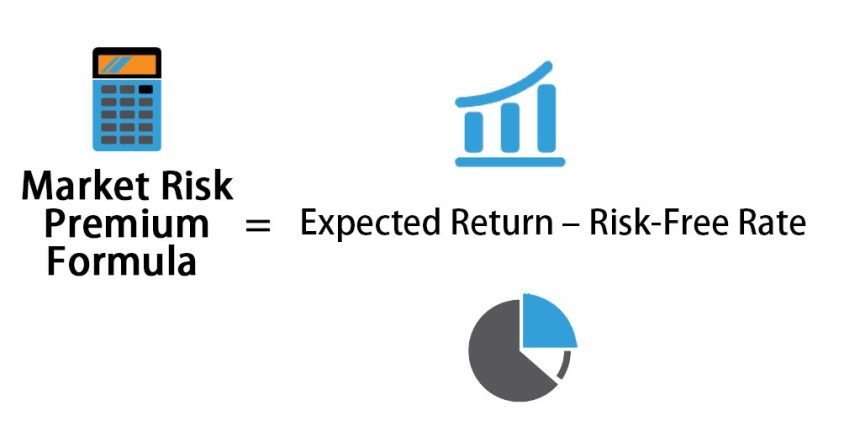Since the 2008 financial crisis, top valuation and management practitioners alike have witnessed major changes in the underlying factors that are used to determine the value of companies. One of the important indicators is market risk premium.
In this guide, we are going to help you understand the core concept of market risk premium. Along with that, we will also discuss other related stuff. So if you are intrigued to learn more about the market risk premium 2021, give this article a read.
What is a market risk premium?
Before we move onto any further details, we need to answer ‘what is market premium?’
The market risk premium is recognized as a return on a risky investment. It is the difference between the risk-free rate and expected return on a marketplace return.
It is used by investors with a risky portfolio. It is a part of the Capital Asset Pricing Model which is needed to determine the rates of ROI. Ideally, an investment with low risks gives a high rate of return. But in certain situations taking a risk can bring you greater rewards.
Also see: How to lower risk premium rates and keep premium down
Understanding Market Risk Premium
As already explained once, risk premium refers to the rate of return on investment over and above the guaranteed or risk-free rate of return.
To calculate risk premium, you need to first calculate the estimated expected return and the guaranteed rate of return. The estimated return on a stock is the amount of profit/loss that you are expecting from a particular investment.
It should be made clear that an expected return is just a projection. It is not a guaranteed return. By calculating the estimated return, you can easily assess the risk of a particular investment.
The guaranteed rate of return on investment doesn’t involve any financial loss. But it has a lower rate of return because the risk is low.
If the expected rate of return is lesser than the guaranteed rate, then it results in a negative risk premium.
Types of Market Risk Premium
Several things need to be taken into account when determining the overall market risk premium. Speaking of which, there are different types of market risk premiums. This include:
-
Historical market risk premium
The past performance of the return is used to determine the risk premium. This can vary based on the instrument used. Generally, they use S&P 500 as a benchmark for analyzing the return’s past performance.
-
Required market risk premium
This refers to the minimum rate of return that investors should take into account. It is also known as the hurdle rate of return. If your required market risk premium is too low, you are likely to have a hard time getting investments. However, this will vary from investor to investor.
-
Expected market risk premium
The expected market risk premium is based on expectations. It changes based on the investor involved.
-
Default market risk premium
A default risk premium refers to the extra amount that a borrower is required to pay to compensate a lender for assuming default risk. Just so you know all borrowers or companies indirectly pay a default premium. However, the rate at which they must repay the obligation varies from lender to lender.
-
Equity market risk premium
Equity risk premium can be described as the excess return that you get from investing in the stock market. It is calculated over a risk-free rate. This excess return is used to compensate the investors for taking on the higher risk of equity investing.
-
Maturity market risk premium
A maturity risk premium is the extra amount of return you receive on your investment when you purchase a bond with a longer maturity date. It is used to compensate investors for taking on the risk of holding bonds over a long period.
Market Risk Premium Formula: How to calculate it?
The market risk premium can be calculated by deducting the guaranteed rate from the expected equity market return. Once you calculate the equity risk premium, you can use it in important calculations such as CAPM.
Between the period 1926 and 2014, the S&P 500 had a 10.5% compounding annual rate of return, while the 30-day Treasury bill compounded at 5.1%. This indicates a 5.4% market risk premium based on these parameters.
The required rate of return for a particular asset can be calculated by multiplying the beta coefficient of the asset by the market coefficient. And then adding back the guaranteed rate. This is commonly used in discount rates in discounted cash flow.
The market risk premium formula is as follows:
- Market Risk Premium = Expected Rate of Return – Guaranteed (Risk-Free) Rate
- Market risk premium = Market rate of return – Risk-free rate of return
If you are wondering how to calculate market risk premium, let’s give you an example.
Let’s say the S&P 500 produced a return of 8% the last year and the current interest rate of the Treasury bill is 4%. The market risk premium is 8% – 4% = 4%.
Just follow the formula mentioned above and it should be easier for you to calculate the market risk premium.
Explanation of the Market Risk Premium Formula
The first formula mentioned in the above section can be derived by following these simple steps given below:
- The first thing you need to do is determine the estimated rate of return for the investors depending on their risk appetite. The higher the risk, the higher would be the estimated rate of return. This is needed to compensate for the additional risk.
- The next thing you need to determine is the guaranteed or risk-free rate of return. This refers to the return that is expected without the investor taking any risk at all. The return on treasury bills or government bonds is good proxies for the guaranteed rate of return.
- You can finally derive the market risk formula by deducting the guaranteed rate of return from the expected rate of return, as mentioned in the first formula.
The second formula for market risk premium can be derived by following these three simple steps:
- First, you must determine the market rate of return. This is the annual return of a suitable benchmark index. The return on the S&P 500 index is a good proxy for the market rate of return.
- Next, you need to determine the guaranteed rate of return for the investor.
- Finally, you can derive the formula for market risk premium by subtracting the guaranteed rate of return from the market rate of return.
Use of Market Risk Premium
As already mentioned once, market risk premium makes a part of the Capital Asset Pricing Model.
In the CAPM, the return of an asset is the guaranteed rate, plus the premium, multiplied by the asset’s beta. The beta refers to the risk associated with an asset and is compared to the overall market. The premium is adjusted based on the risk of the asset.
An asset with zero risks has zero betas. In this case, the market risk premium will be canceled. On the other hand, a risky asset, with a beta of 0.8, would take on almost the full market risk premium. At 1.5 beta, the asset is 150% more volatile than the market.
Volatility
It is important to understand that the relationship between reward and risk is the main premise behind market risk premiums.
If you receive 10% security returns every time, it has zero volatility of returns.
On the other hand, if you receive 20% security returns in period one, 30% in period two, and 15% in period three, it will have higher volatility of returns. This is why it is considered riskier. This is where you need risk-adjusted returns.
Interpretation of the market risk premium:
The risk of the investment increases with the equity market risk premium. The higher the equity risk premium, the higher is the risk of the investment. This means the investor will expect higher returns with higher risks.
Pros of the market risk premium:
- Easy to use
- The investor has a good idea about the investment
Cons of the market risk premium:
- Very subjective
- Risky affair
Conclusion
The concept of market risk premium may seem to be intimidating in the beginning. But as you start getting deep into the stock market and investment world, you will gradually get the hang of it. Hopefully, you found this post helpful.
FAQs
How to calculate market risk premium?
There are two formulas that you can use to calculate the market risk premium.
- Market Risk Premium = Expected Rate of Return – Guaranteed (Risk-Free) Rate
- Market risk premium = Market rate of return – Risk-free rate of return
What is risk premium?
Just in case you are confused, both risk premium and market risk premium are similar terms. But they are used in different contexts. Therefore, there is no difference between the two except scope.
Why is market risk premium important?
The market risk premium is important as it helps in analyzing the asset allocation and the estimation of the company. Companies and investors use it to make investment related decisions.















